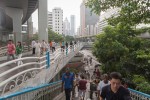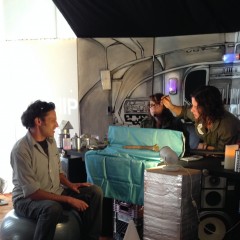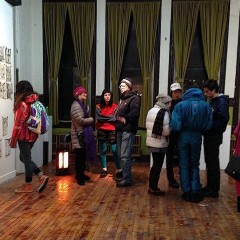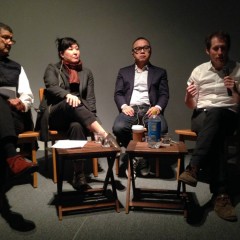We met Aaron Levy over coffee a while back to talk about theory. Levy, if you don’t know him, is the executive director of Slought Foundation, the gallery and event space with intellectual chops just on the edge of the campus of the University of Pennsylvania. He’s also a curator and, what we didn’t expect to hear, a red diaper baby. He grew up in a dialectical vegetarian household that didn’t celebrate holidays, and at age 30-something he’d just been to his first Thanksgiving dinner, with friends, in New York.
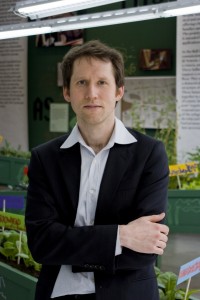
Levy, who is Slought’s senior curator, is writing his PhD dissertation in art history and cultural studies at the University of Leeds–1,000 words a day with a goal of 40,000 words total (he is at around 24,000 when we meet him). He co-founded Slought Foundation with artist Osvaldo Romberg and philosopher Jean-Michel Rabate. Slought’s program is full of philosophical questioning, serious discussion, and art from around the world.
Before we sit down at the Metropolitan Cafe next to the gallery, we have a moment of confusion with the cashier that allows Levy to pick up the check for one of our drinks. We try to pay him back the $2, but he stands firm, and at some point to not accept would have been churlish. Nonetheless, suddenly we find ourselves co-opted. Can we write up this interview fairly? Although it was unintentional, we are definitely implicated by this simple civility.
And that is the main point that Levy’s conversation leads us to and one of the main words he uses over and over–implicated. We are all implicated in each other’s worlds. So how can the role of the artist — the outsider critiquing society — work today if we’re all implicated? How can you be an artist and make serious, socially critical work that has not been co-opted by the very society you are criticizing?
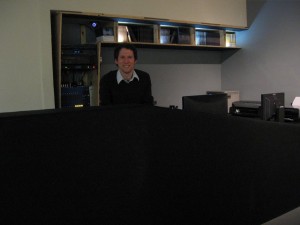
But that’s not where we start the conversation. We start by asking him to tell us about theory, what it is, what is its use in the world of art.
His answer is that philosophy is hysterical questioning.
What’s that, we ask. “Hysterical questioning is ongoing questioning about the world around you. There’s something anti-authoritarian about that position. It calls into question everything. It’s similar to the role of the artist in the ’60s and ’70s.”
So Levy sees the artist as a social critic. And he says that you can see how that plays out in the ’60s and ’70s in the dematerialization of the art object. Referring us to Lucy Lippard‘s book, Six Years: The Dematerialization of the Art Object (1973), he explains that things like land art, performance art, Dennis Oppenheim carving in ice were all new forms of practice — developed in opposition to minimalism’s focus on the object and its monumentality.
Other forms of opposition in that era include experimentation with collectives and belonging. “That’s what you see coming back today in Philadelphia.”
Another characteristic of the 60s and 70s is a clearer line drawn between the center and the periphery, he says. “Institutions like the New Museum and PS 1 were coming into being for the practice and exhibition of artwork through oppositional logic. PS 1 had a bombed out aesthetic, with holes in the wall. It was attractive and oppositional to the white box at MoMA.
Why is it important for art to be oppositional, we ask.
“It is [important] only if you believe that art has that role — to oppose. I believe art has a responsibility (expressed through oppositionalism). In the ’60s and ’70s, there was an interest in probing the limits of the social order. Romantic as it is, I still believe it’s the role of the artist — to question and redefine.”
We want to hear how Levy would apply theoretical ideas to what’s happening here in Philadelphia. “I don’t know that the questions in Philadelphia are different from the questions elsewhere, except that DIY culture is a big practice here.” But then he points to the poverty rate in Philadelphia (20 percent) and in Mantua, the neighborhood just north of Slought, (60 percent). He suggests art needs to ask questions about that.
However, most art isn’t oppositional, he says, because to survive and get attention today art needs to be easy to take in quickly; and it needs to have spectacle — which is inappropriate next door to such poverty.
We are interested in his idea about spectacle and the constant desire for newness and what we are seeing as the ever-increasing homogeneity of the art world. What we’ve observed is that people (gallerists, collectors, artists) desire something new and spectacular, something for immediate consumption. But will that produce the most interesting practices? And with cultural tourism dependent on providing spectacle, what happens to more thoughtful, slower work that is not new or spectacular.
He says, “We have a perpetual desire for perpetual spectacularity. For me it’s a vexed question. Is it possible not to be subservient to the new and spectacular and to the allure of entertainment?”
But why fight spectacle at the risk of being marginalized, we ask. He is worried that by using spectacle the artist is implicated in society and its values, is co-opted, and is no longer fulfilling the function of critiquing society. But then, he says, “An artwork is a fairly small gesture, as much as I want it to be (bigger). Art can only do so much. There are no answers to these questions, only perpetual questions, questions only meant to serve as productive generators of practice. Humility may be what we need today more than hubris.”
Humility –this seems a new theoretical idea to us. Is anybody else talking about humility as the way to the future?
“I don’t know. There was a book about slowness in architecture a while ago. Nobody is writing about this. We need more writing about it but I can’t get up and speak about modesty in a public forum (because I’ll look immodest). It’s an aporia…(philosophical puzzle).”
Levy co-curated the project, Into the Open for the American architecture pavilion at the 2008 Venice Biennale and that effort was about showing real world issues of poverty, environmental activism and equal housing activism. The whole thrust of the exhibition was anti-spectacle. And the difficulty with that, he says, is, “It’s a downer. Here’s a project in the most fun pavilion (the US pavilion) in a biennial that was called a “fun palace” by one media critic. And we were modest….”
This “modesty proposal” is clearly not for everyone. But then Levy defines art in a slightly different way from most people; he talks about how research can be art whether or not it results in a product or exhibit. We wonder if he is saying in a roundabout way that there is too much art out there. “Yes,” he says.
And apparently others are thinking that thought as well. Levy tells us that at the recent panel discussion on the 50th anniversary of the Percent for Art program in Philadelphia, at which he was moderator, the discussion was about how we don’t need more public art but how we need new forms of “public” and new forms of art. As surprised as he was to hear this, he applauds that thinking.
New definitions of public and art are what the Public Art Fund and Creative Time in New York are all about. So, we are thinking it’s interesting that public art people in Philadelphia are groping towards those models, in which art is temporary and ephemeral in nature and has less of an obligation to please and more latitude to raise questions.
“And that’s why theory is so important today. It can help us figure out new ways forward.”
But who’s writing this theory and what are they saying, we ask.
“Artforum,” he says, pointing to Antonio Negri‘s political writings about multitudes and post-colonial concerns. Also, anything by Jacques Ranciere.
“Theory could be radical, like the Situationists or Futurists. There is revolutionary potential,” he says. “If theory is popularized, its revolutionary potential is co-opted, becoming hip and fashionable like every other commodity. It has to be more than something to read on Sunday morning and then you go out shopping.”
“I am interested in the theory of implication. I tell my students about Theodore Adorno and his writings on the culture industry. We see more than 1,000 ads a day and are incredibly implicated by the world around us. Theory could help us contextualize.”
“Today there is only the inside [not the center and the periphery]. We are all inside. We are all shiny and new. I like shiny and new. But there is more. Theory allows us to sit back and think about our situation.”


